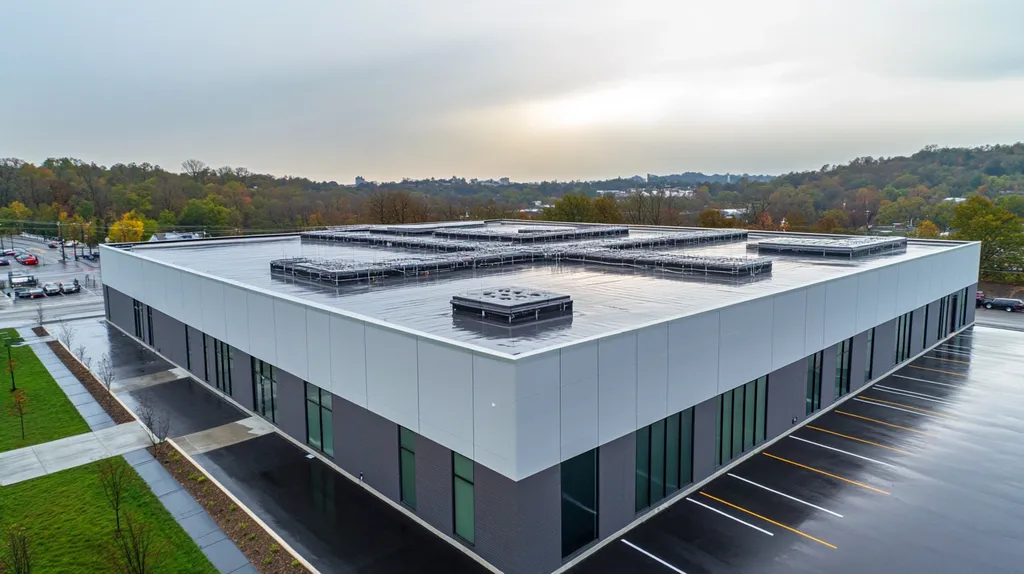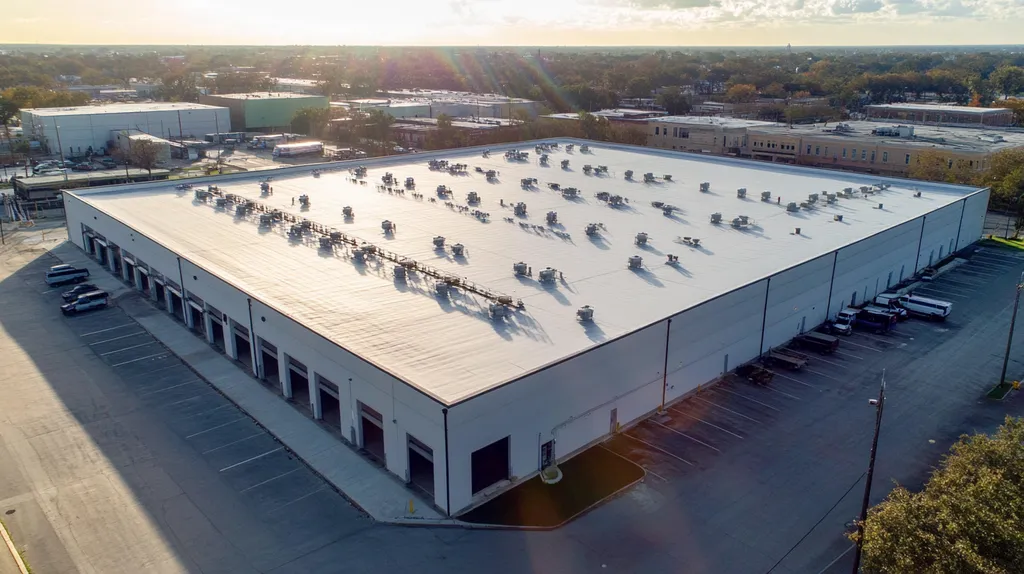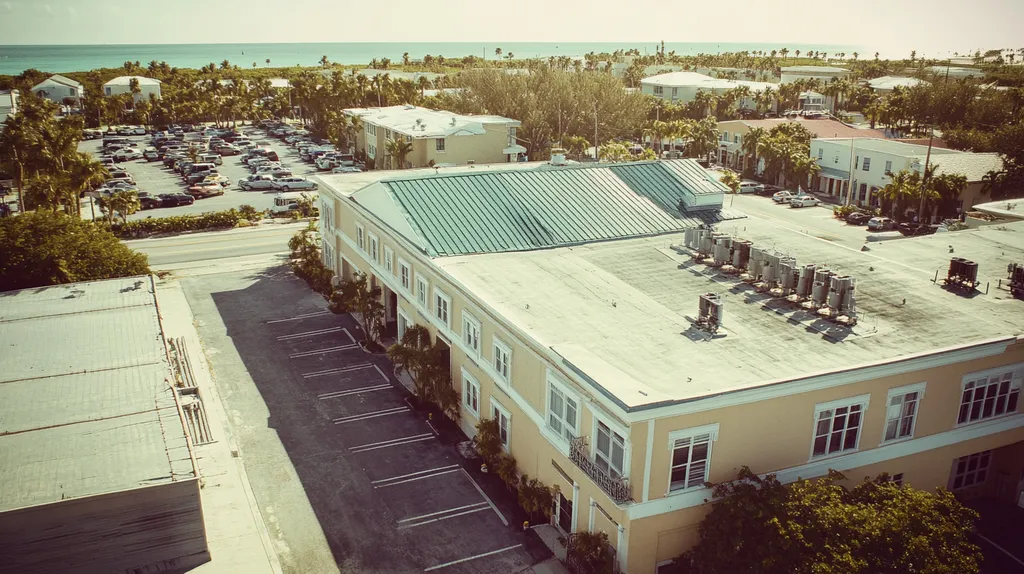Welcome to today’s Battle Royale featuring two roofing heavyweights: “Polyurea” in the east corner versus “Epoxy” in the west!
Tonight’s showdown pits these contenders against each other across six punishing rounds designed to test every aspect of their performance for Chemical Resistance of Commercial Roof Coatings for Spills.
At stake? Millions in potential costs, decades of building protection, and the critical performance demands of modern commercial and industrial facilities.
Our professional judging panel will evaluate each round on technical merit, real-world performance, and value delivery. After all six rounds, we’ll declare our ultimate champion.
Ladies and gentlemen, facility managers and building owners… it’s time to rumble!
ROUND 1: INITIAL COSTS & INSTALLATION
When chemical spills occur on commercial roofs, the coating’s performance becomes critical to protecting the building’s structural integrity and occupant safety. Making the wrong choice between polyurea and epoxy coatings can lead to premature failure, extensive repair costs, and potential environmental compliance issues. This analysis examines the crucial factors of material expenses, installation requirements, and project timelines that impact initial deployment.
Material Expenses
Initial material costs significantly impact project budgets and must be weighed against long-term performance requirements. Raw material expenses for polyurea coatings typically range 30-40% higher than traditional options due to their advanced chemical formulations.
The specialized nature of polyurea components contributes to their premium pricing, but their durability and resistance to a broad spectrum of chemicals offset these costs through extended service life.
Epoxy systems present lower upfront material costs, making them initially attractive for budget-conscious projects. However, their susceptibility to UV degradation and certain chemical exposures often necessitates more frequent recoating.
While polyurea commands a higher initial investment, its superior chemical resistance and longevity establish it as the more cost-effective solution, earning the “ADVANTAGE” in material value.
Installation Complexity
Successful installation demands precise application conditions and skilled labor to ensure optimal performance. Polyurea requires specialized spray equipment and certified applicators, limiting the contractor pool and potentially increasing labor costs.
The application window for polyurea is particularly critical, as environmental conditions must be strictly controlled. However, once properly applied, the rapid cure time minimizes vulnerability to weather events during installation.
Epoxy applications involve simpler equipment and more forgiving application parameters. The wider availability of qualified installers and conventional application methods typically results in lower installation costs.
Given the accessibility and straightforward nature of epoxy installation, it claims the “ADVANTAGE” in this category.
Project Timeline
Speed of installation and return to service directly impact facility operations and project costs. Polyurea’s rapid cure technology allows for same-day return to service, dramatically reducing facility downtime.
The quick-set nature of polyurea means weather delays have minimal impact on project schedules. Multiple coats can be applied in rapid succession, accelerating overall completion times.
Epoxy systems require extended cure times between coats, typically 24-48 hours under ideal conditions. This longer curing period increases project vulnerability to weather delays and extends facility disruption.
The significant reduction in installation time and faster return to service gives polyurea the clear “ADVANTAGE” in project timeline considerations.
ROUND 1 WINNER: Polyurea
ROUND 2: DURABILITY & LIFESPAN
Chemical spills on commercial roofs present a critical threat to building integrity and safety compliance. When roofing coatings fail under chemical exposure, repair costs can escalate into six figures, while environmental remediation expenses can reach even higher. Understanding how polyurea and epoxy coatings perform under harsh chemical conditions is essential for protecting both infrastructure investments and operational continuity.
Impact of Chemical Exposure
Chemical resistance directly affects coating longevity and maintenance requirements. Exposure to industrial chemicals, acids, and solvents can rapidly degrade traditional roofing materials, leading to premature system failure.
Polyurea demonstrates exceptional resistance to a broad spectrum of chemicals, maintaining its structural integrity even under prolonged exposure. Its molecular structure creates an impermeable barrier that prevents chemical penetration and subsequent degradation.
Epoxy coatings offer good initial chemical resistance but can become brittle and deteriorate when exposed to certain compounds. Their performance varies significantly based on specific chemical formulations and exposure conditions.
Given its superior chemical resistance profile, polyurea claims the clear ADVANTAGE in this category.
Weather Resistance and Temperature Stability
Roofing coatings must withstand extreme temperature fluctuations while maintaining their protective properties. Daily thermal cycling and seasonal changes create constant stress on coating systems.
Polyurea maintains flexibility across a temperature range from -40°F to 350°F. This elasticity allows it to expand and contract without cracking or separating from the substrate.
Epoxy systems become increasingly brittle at low temperatures and can soften excessively in high heat. This thermal sensitivity can lead to coating failure, particularly when combined with chemical exposure.
Polyurea’s superior temperature stability and weather resistance earn it the ADVANTAGE in this category.
Maintenance and Repair Considerations
The ease and frequency of maintenance directly impact long-term coating performance and facility operations. Regular inspections and prompt repairs are essential for maximizing service life.
Polyurea’s durability typically requires minimal maintenance beyond routine inspections. When repairs are needed, its rapid cure time allows for quick completion with minimal facility disruption.
Epoxy systems often require more frequent maintenance due to UV degradation and chemical wear. Repairs can be complicated by adhesion issues and extended cure times.
With lower maintenance requirements and simpler repair protocols, polyurea secures the ADVANTAGE in maintenance considerations.
ROUND 2 WINNER: POLYUREA
ROUND 3: PERFORMANCE FACTORS
Chemical resistance in commercial roof coatings directly impacts building protection and operational safety. When roofing systems fail due to chemical exposure, replacement costs can exceed $500,000 for large facilities, while environmental remediation and regulatory fines can push expenses even higher. Analyzing performance factors helps facility managers avoid these costly scenarios.
Chemical Resistance
Chemical resistance determines how well a coating maintains its protective properties when exposed to harsh substances. Industrial environments frequently expose roofing systems to corrosive chemicals, oils, and solvents that can rapidly degrade traditional coatings.
Polyurea demonstrates exceptional resistance across a broad spectrum of chemical exposures. Its molecular structure creates an impermeable barrier that maintains integrity even under prolonged contact with aggressive substances.
Epoxy coatings offer good initial chemical resistance but can become compromised when exposed to certain industrial chemicals. Their performance varies significantly based on exposure conditions and specific chemical formulations.
The superior chemical resistance profile of polyurea earns it the ADVANTAGE in this category.
Durability Under Different Conditions
Environmental factors like UV exposure, temperature fluctuations, and moisture significantly impact coating performance. These conditions can accelerate degradation and reduce chemical resistance over time.
Polyurea maintains its protective properties and flexibility across extreme temperature ranges. This elasticity allows it to accommodate building movement and thermal cycling without compromising its chemical barrier properties.
Epoxy systems become increasingly brittle with age and UV exposure. This degradation can lead to cracking and coating failure, particularly when combined with chemical exposure.
The superior environmental durability of polyurea secures the ADVANTAGE in this category.
Ease of Maintenance
Maintenance requirements directly affect long-term performance and facility operations. Regular inspections and proper cleaning protocols are essential for maintaining chemical resistance.
Polyurea coatings typically require minimal maintenance beyond routine inspections. Their smooth surface resists chemical adhesion and simplifies cleaning procedures.
Epoxy systems often need more frequent maintenance due to surface degradation and chemical absorption. Their porous nature can trap contaminants, making thorough cleaning more challenging.
With lower maintenance demands and simpler cleaning requirements, polyurea claims the ADVANTAGE in this category.
ROUND 3 WINNER: POLYUREA
ROUND 4: MAINTENANCE REQUIREMENTS
Effective maintenance of chemical-resistant roof coatings directly impacts building protection and operational costs. Industry data shows that poorly maintained coatings can fail in less than half their expected lifespan, leading to premature replacement costs exceeding $200,000 for typical commercial facilities. Understanding maintenance requirements helps facility managers protect their coating investment and ensure continuous chemical resistance.
Regular Inspection Requirements
Proactive inspection protocols are essential for maintaining chemical resistance in roof coatings. The frequency and complexity of these inspections directly affect both maintenance costs and coating performance.
Polyurea coatings typically require bi-annual inspections focusing on seams, penetrations, and high-traffic areas. Their resistance to degradation and mechanical damage means these inspections are primarily preventive rather than corrective.
Epoxy systems demand quarterly inspections due to their susceptibility to UV degradation and chemical absorption. These more frequent inspections must carefully evaluate surface integrity and coating thickness.
With lower inspection frequency and simpler protocols, polyurea claims the ADVANTAGE in this category.
Cleaning and Surface Preparation
Regular cleaning prevents chemical buildup and maintains coating effectiveness. The method and frequency of cleaning directly impact long-term performance.
Polyurea’s smooth, non-porous surface resists chemical adhesion and contamination. Standard pressure washing with mild detergents is typically sufficient for maintenance cleaning.
Epoxy coatings often require aggressive cleaning methods to remove absorbed chemicals and surface contamination. Their porous nature can trap contaminants, necessitating more frequent and intensive cleaning protocols.
Based on easier cleaning requirements and superior contamination resistance, polyurea earns the ADVANTAGE.
Repair and Recoating Procedures
The complexity and frequency of repairs significantly affect facility operations and maintenance budgets. Quick, effective repairs are crucial for maintaining chemical resistance.
Polyurea repairs can typically be completed within hours, with excellent adhesion to existing coating. The rapid cure time minimizes facility disruption and quickly restores chemical resistance.
Epoxy repairs require extensive surface preparation and longer cure times. Environmental conditions can further extend repair windows, leaving the roof vulnerable to chemical exposure.
With faster repairs and better repair bonding, polyurea secures the ADVANTAGE in this category.
ROUND 4 WINNER: Polyurea
ROUND 5: SUSTAINABILITY CREDENTIALS
Environmental regulations and sustainability requirements are reshaping commercial roofing decisions. With chemical spill protection now intersecting with green building standards, facility managers must balance environmental compliance with performance. Poor sustainability choices can result in regulatory fines exceeding $100,000 while also increasing operational costs through higher energy consumption and shortened coating lifespans.
Environmental Impact
Chemical-resistant roof coatings must meet increasingly stringent environmental standards while maintaining their protective capabilities. Modern facilities face dual pressures of environmental compliance and chemical containment performance.
Polyurea coatings typically contain minimal volatile organic compounds (VOCs) and can be applied in thicker layers, reducing the number of applications needed. Their rapid cure time also minimizes emissions during installation.
Epoxy systems often require multiple coats and contain higher levels of VOCs, increasing their environmental impact during application. Their shorter lifespan also means more frequent replacement and associated material waste.
With lower emissions and reduced material consumption, polyurea claims the ADVANTAGE in environmental impact.
Lifecycle Assessment
The total environmental impact of roof coatings extends from manufacturing through disposal. Energy consumption, maintenance requirements, and service life all factor into sustainability calculations.
Polyurea’s exceptional durability and chemical resistance result in longer service life, typically 20-25 years. This longevity reduces replacement frequency and associated environmental impacts.
Epoxy coatings generally require replacement every 7-10 years when exposed to chemical environments. More frequent replacement cycles increase energy consumption and material usage throughout the coating’s lifecycle.
Based on superior longevity and reduced replacement needs, polyurea earns the ADVANTAGE in lifecycle assessment.
Recyclability and Waste Management
End-of-life considerations significantly impact a coating’s overall environmental footprint. Proper disposal of chemical-resistant materials presents unique challenges and costs.
Polyurea coatings, while difficult to recycle, produce less waste volume due to their longer service life. Their chemical stability also reduces the risk of environmental contamination during disposal.
Epoxy systems generate more frequent waste through shorter replacement cycles. Their chemical composition often requires specialized disposal procedures, increasing environmental impact.
The reduced waste volume and lower disposal frequency gives polyurea the ADVANTAGE in waste management.
ROUND 5 WINNER: Polyurea
ROUND 6: SPECIALIZED APPLICATIONS
Chemical spills on commercial roofs create immediate threats to building integrity and occupant safety. Facilities handling hazardous materials face potential losses exceeding $500,000 from a single significant spill event, not including regulatory fines or business interruption costs. Specialized applications demand roofing solutions that deliver reliable chemical resistance while accommodating unique facility requirements.
Resistance to Specific Chemicals
Chemical storage areas and process facilities require roofing systems capable of withstanding prolonged exposure to harsh substances. The concentration, temperature, and duration of chemical contact directly impact coating performance and longevity.
Polyurea demonstrates exceptional resistance across a broad spectrum of industrial chemicals, including acids, bases, solvents and petrochemicals. Its molecular structure maintains integrity even under extended exposure to aggressive substances.
Epoxy systems offer good initial resistance but show vulnerability to specific chemical families, particularly organic solvents and oxidizing agents. Their performance can degrade significantly when exposed to multiple chemical types simultaneously.
The comprehensive chemical resistance profile of polyurea earns it the clear ADVANTAGE in this category.
Speed of Application in Emergency Situations
When chemical containment failures occur, rapid deployment of protective coatings becomes critical. Every hour of delay increases the risk of structural damage and regulatory compliance issues.
Polyurea’s rapid cure technology allows for same-day application and return to service, even in emergency scenarios. The quick-set nature minimizes facility disruption while providing immediate chemical protection.
Epoxy applications require extended cure times between coats, typically 24-48 hours under ideal conditions. This prolonged installation window leaves facilities vulnerable during critical periods.
Given its superior rapid-response capabilities, polyurea claims the ADVANTAGE in emergency applications.
Longevity and Maintenance Considerations
Chemical exposure accelerates coating degradation, making long-term performance essential for specialized applications. Regular maintenance requirements directly impact facility operations and protection levels.
Polyurea maintains its protective properties with minimal maintenance beyond routine inspections. Its resistance to chemical absorption and degradation extends service life while reducing maintenance demands.
Epoxy systems require more frequent maintenance and often show signs of degradation within 5-7 years of chemical exposure. Their susceptibility to chemical absorption can compromise long-term performance.
With superior longevity and reduced maintenance needs, polyurea secures the ADVANTAGE in this category.
ROUND 6 WINNER: POLYUREA
AND THE WINNER IS…
After six punishing rounds of technical evaluation, we have our verdict. In a decisive victory, scoring a knockout in EVERY round, our new undisputed champion of chemical-resistant roof coatings is… POLYUREA!
This powerhouse performer dominated with superior chemical resistance, exceptional durability, and lightning-fast installation capabilities. From sustainability credentials to specialized applications, polyurea demonstrated championship-caliber performance across every category.
Yet even in defeat, epoxy proves it’s no pushover. For budget-conscious projects with minimal chemical exposure risks and standard environmental conditions, epoxy remains a solid contender worthy of consideration.
Important Notice: While this analysis reflects general performance characteristics, every facility faces unique challenges. Local climate conditions, specific chemical exposures, and building characteristics can significantly impact coating performance. Property owners and managers should always consult with qualified roofing professionals to evaluate their specific requirements and conditions.
Ladies and gentlemen, in the high-stakes arena of chemical-resistant roof coatings, there’s no room for second chances. Choose your champion wisely, because when chemical spills strike, you need a proven performer in your corner!
FREQUENTLY ASKED QUESTIONS
Q. What are the initial costs for commercial roof coatings?
A. Initial material costs vary significantly, with polyurea typically 30-40% higher than epoxy. While the upfront price for epoxy may appeal to budget-conscious projects, its frequent recoating requirements often lead to increased long-term expenses. Polyurea’s durability justifies its higher initial cost, offering better value over time.
Q. How do durability and lifespan compare for industrial roofs?
A. Polyurea coatings generally outperform epoxy in terms of durability and lifespan. Polyurea can maintain structural integrity under prolonged chemical exposure, while epoxy tends to become brittle over time, shortening service life. This helps avoid costly repairs and delays in operations, enhancing overall effectiveness in industrial settings.
Q. What performance factors should I consider for my commercial roof?
A. Key performance factors include chemical resistance, environmental durability, and ease of maintenance. Polyurea excels in these areas, providing superior resistance to various chemicals and environmental stresses. This performance ensures that your commercial roof remains robust and reliable under harsh conditions, ultimately reducing maintenance needs and associated costs.
Q. What maintenance requirements can I expect for commercial roof coatings?
A. Maintenance for commercial roof coatings varies, but polyurea generally requires less frequent inspections compared to epoxy systems. Polyurea typically needs bi-annual checks while epoxy requires quarterly due to UV degradation. This difference in maintenance frequency can lead to considerable time and cost savings for facilities managers.
Q. How do sustainability credentials differ for commercial roof systems?
A. Sustainability credentials hinge on environmental impact, lifecycle assessment, and waste management. Polyurea generally offers lower VOC emissions and longer service life, reducing overall waste and material usage. Epoxy, with its shorter lifespan and higher emissions, presents greater environmental challenges, making polyurea the more sustainable choice in many commercial applications.
Q. What specialized applications benefit from polyurea coatings?
A. Specialized applications, such as chemical storage facilities, benefit significantly from polyurea coatings. Their robust chemical resistance ensures protection against a wide variety of aggressive substances, minimizing degradation risks. Polyurea’s rapid application also aids in quickly addressing containment needs during emergencies, highlighting its effectiveness in high-risk environments.
Q. How can I determine the best commercial roof coating for my needs?
A. To determine the best coating, assess the specific environmental conditions, chemical exposures, and budget constraints of your facility. Consider factors such as longevity, maintenance needs, and installation complexities. Consulting with roofing professionals can also provide valuable insights tailored to your unique requirements, ensuring optimal protection and cost-efficiency.










